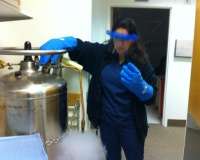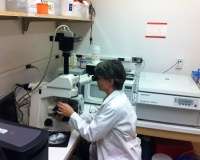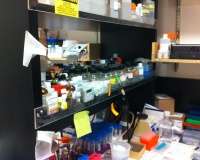Plastic Surgery
Laboratory Resources
Find your care
Our team is made up of experts and leaders in the art and science of plastic surgery. To learn more about our services, call 310-825-5510.
Safety

- The Environment, Health & Safety Program - the EH&S Laboratory Safety Program exists to keep campus labs safe and secure. Integral to this are safety culture, training, accountability and oversight, and inventory and recordkeeping. This resource contains information and resources for all lab personnel.
Resources
- Laboratory Hazard Assessment Tool login - the LHAT can be accessed by Principal Investigators (PIs) or their authorized designees to identify laboratory hazards and specify the appropriate personal protective equipment (PPE).
- Job Safety Analysis Templates- JSAs are used to describe how to perform a task step-by-step, any hazards associated with a task, and controls to mitigate these hazards. JSAs can be used to educate employees on safe practices prior to utilizing equipment.
- Hazardous Waste Pickups - scheduled pick-ups are only for routinely generated waste. For lab clean-outs, large, or special pick-ups call Environment, Health & Safety (EH&S) at (310) 206-1887 for instructions.
- Safety Fact Sheets - EH&S Fact Sheets can be used to supplement training materials, as safety meeting hand-outs, and as resources when conducting new work activities.
- How to Report an Injury - Employees should obtain medical treatment at OHF for non-emergencies that occur during normal business hours, or at RRUCLAMC for emergencies and/or off-hours treatment. Report serious injuries within 8 hours to the EH&S Hotline: 310-825-9797 (The EH&S Hotline is monitored 24 hours a day, 7 days a week).
Training

- Classroom Training - Environmental Health and Safety conducts classroom training on a variety of topics. Please consult with your supervisor / PI to determine which sessions are required for your specific job duties.
- Laboratory Safety Fundamental Concepts (LSFC) Online Refresher - The online refresher provides an overview of lab safety requirements. Topics of discussion include: the recognition and mitigation of laboratory hazards; the use of engineering controls, administrative controls and personal protective equipment; working safely with chemicals, the use of MSDSs, procedures for disposing of hazardous chemical waste; fire safety precautions for the laboratory; and ergonomic tips.
- EH&S Online Learning Center - a campus and medical center resource for Online Health and Safety Training.
- The Collaborative Institutional Training Initiative (CITI) - the CITI Program is a subscription service providing research ethics education to all members of the research community. To participate fully, learners must be affiliated with a CITI participating organization.
- Contracts & Grants Administration Training Website - the online courses in Contract and Grant Administration are intended for employees who currently perform or anticipate assuming duties and responsibilities related to the administration of contracts and grants.
- The Division of Laboratory Animal Medicine (DLAM) Online Training Site - the DLAM offers training opportunities for the UCLA animal research community to ensure animal well-being and regulatory compliance. These training opportunities offered by DLAM are free of charge, and designed to facilitate Animal Research Committee (ARC) requirements.
Manual

- Lab Safety Manual - laboratory safety is an integral part of laboratory research and is critical to achieving the University's goal expressed in UCLA Policy 811 of preventing workplace injuries and illnesses, environmental incidents and property losses or damage.
- The Chemical Hygiene Plan (CHP) - the CHP establishes a formal written program for protecting laboratory personnel against adverse health and safety hazards associated with exposure to potentially hazardous chemicals and must be made available to all employees working with hazardous chemicals. The CHP describes the proper use and handling practices and procedures to be followed by faculty, staff, students, visiting scholars, and all other personnel working with potentially hazardous chemicals in laboratory settings.
- In Case of Serious Injury (Poster) - a poster detailing the steps to take in the event of a serious workplace or laboratory injury.
Policies

- UCLA Policy 811: Environmental Health & Safety - the University of California is committed to achieving excellence in providing a healthy and safe working environment, and to supporting environmentally sound practices in the conduct of University activities. It is University policy to comply with all applicable health, safety and environmental protection laws, regulations and requirements. All University activities are to be conducted in a manner that ensures the protection of students, faculty, staff, visitors and the environment.
- UCLA Policy 905: Research Laboratory Personal Safety and Protective Equipment - pursuant to state and federal regulations, and in an effort to prevent workplace injuries and illnesses, UCLA has established this Policy regarding Personal Protective Equipment (PPE) requirements for all campus research laboratory faculty, staff and students.
- UCLA Policy 907: Safe Handling of Particularly Hazardous Substances - this policy provides general guidance on how to work safely with chemicals that have been designated as "particularly hazardous" by Cal/OSHA. It describes the minimum requirements for the safe storage, use, handling, and disposal of particularly hazardous substances, including spill and accident response procedures. Particularly hazardous substances are defined by Cal/OSHA as: reproductive toxins, acutely toxic substances and select carcinogens, which include regulated carcinogens. Refer to Attachment A, Particularly Hazardous Substances Definitions, for specific definitions.
Laboratory Standard Operating Procedure Templates
- Standard Operating Procedure (SOP) Template Library - please use the SOP template below to write your laboratory-specific SOPs. All sections on the SOP template must be completed. Please refer to the corresponding Material Safety Data Sheet (MSDS) from the same manufacturer of the chemical to add important information on the SOPs per the manufacturer recommendations. All SOPs must be reviewed and signed by the laboratory members and documented in the Laboratory Safety Manual binder.